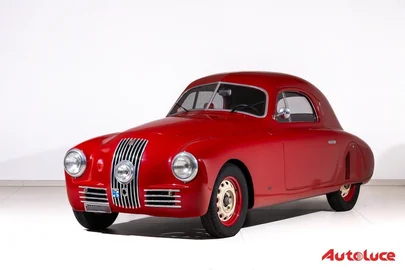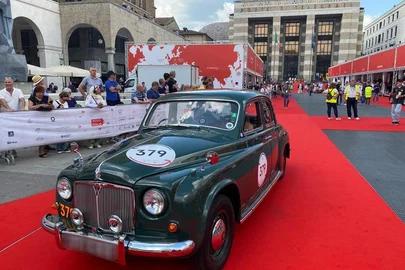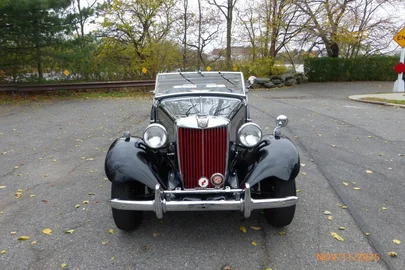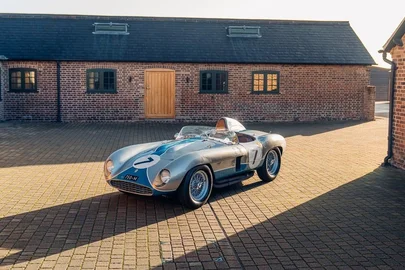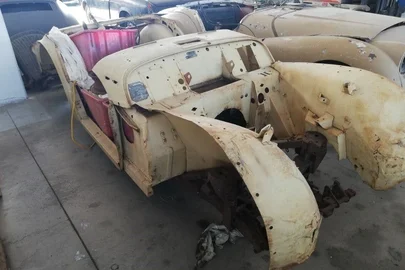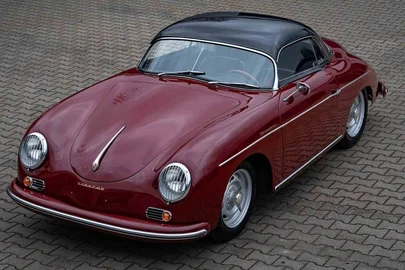
1952' Frazer Nash Le Mans Replica
Diese Anzeige melden!Bewerte!Lesezeichen setzen
VerhandelbarVeröffentlicht 12 Oktober 2020ID: s4zNhd
Abgelaufen
5 Jahre, 3 Monate her
5 Jahre, 3 Monate her
Information from the owner
Karosserie: Sportwagen
Alter: 68 Jahre
Außenfarbe: Grün
Verkäuferkommentare zu 1952' Frazer Nash Le Mans Replica
Bonhams Motor Cars are delighted to return to Goodwood for the 17th October auction during the Goodwood Speedweek event. PLEASE NOTE the event is not open to the public, and viewing of auction lots at Goodwood is available on Tuesday 13th & Wednesday 14th October by appointment only. To view more pictures and a video of each lot please click the link.
THE EX-SIR STIRLING MOSS, TONY BROOKS, ROY SALVADORI, KEN WHARTON
1952 FRAZER NASH LE MANS REPLICA MKII SPORTS
REGISTRATION NO. XMG 6
CHASSIS NO. 421/200/FN176A
ENGINE NO. BS4/MK2/505
*Significant in-period competition history
*Rebuilt in the 2000s
*Raced competitively
*FIA and HTP papers
GBP300,000 - 400,000
€330,000 - 440,000
'XMG 6' has raced extensively in the Motor Racing Legends and Royal Automobile Club Woodcote Trophy series for many seasons. It is a fully FIA and HTP compliant 1950s competition car, whose significant history is associated with legendary greats such as Sir Stirling Moss, Tony Brooks, and Roy Salvadori.
Powered by a 2.0-litre six-cylinder Bristol engine, this Le Mans Replica Mark II, chassis number 'FN176', was driven by Stirling Moss at Monaco and was the second of seven MkII Le Mans Replicas built on the parallel tube chassis. It was fitted with a Bristol BS1 engine; ultra close-ratio gearbox; lightweight Marston radiator and oil cooler; Alfin brake drums with lightened back plates; and lightened bolt-on Austin wheels. The narrower chassis allowed the body to be built to minimum race regulations and was 36" wide at the cockpit with no passenger door. There was a 15½-gallon aluminium fuel tank and the spare wheel was mounted vertically in the boot with a detachable tail section.
The Le Mans Replica was the most sporting model produced by Frazer Nash in its post-war era. Initially called the Competition model, it was renamed in honour of the Frazer Nash that finished 3rd overall at Le Mans in 1949. Only 29 were made between 1949 and 1954, of which only seven were the much rarer MkII version.
This Le Mans Replica was completed in May 1952 and retained as a works race and development car. After completion, it competed in the Prix de Monte Carlo, a race for 2-litre sports cars held on 1st June 1952 as a support race for the Monaco Grand Prix. Stirling Moss set the fastest time in practice to put the car on pole position, but retired whilst disputing 2nd place in the race.
Ken Wharton was then engaged as works driver and he finished 2nd in the car at the Jersey Road Race on 10th July 1952. 'FN176' then won the 100-mile race for sports cars up to 2 litres at Boreham on 2nd August, beating Mike Hawthorn. Wharton then raced the car at Thruxton (3rd), Shelsley Walsh (1st in class), Goodwood (3rd), Castle Coombe (3rd), and Charterhall (4th). At Goodwood in September Wharton used the car in a Formula 2 race.
With a one minute start over larger cars (DB3S Aston Martins, C-Type Jaguars and a 4.1-litre Ferrari) 'FN176' finished 2nd on handicap (3rd on distance covered) in the British Empire Trophy Race on the Isle of Man on 18th June 1953. Tony Brooks then finished 2nd (2-litre class), in the Unlimited Sports Car Race supporting the British GrandPrix at Silverstone on 18th July. Roy Salvadori was at the wheel at Snetterton on 25th July and won the 2-litre sports car race as well as competing in the Formula 2 race. The car then finished 2nd at Goodwood on 28th September in a five-lap sports car race.
This Le Mans Replica was rebuilt during July-August 1954 and renumbered as chassis number 'FN176A'. The chassis was lightened and fitted with ZF limited-slip differential and light alloy-rimmed wire wheels. The engine was changed for 'BS4/504' and a new aluminium-alloy body was fitted. The body was similar to a Le Mans MkII but had a different shaped nose and grille. The colour was Bristol Green. The car was raced by Ken Wharton at Aintree on 2nd October 1954 where it finished 3rd in class, then by Tony Brooks at Snetterton on 9th October finishing 4th in class.
At Goodwood on Easter Monday, 11th April 1955, Brooks finished 2nd in a five-lap race for 2-litre sports cars. He then won the 2-litre class at Silverstone's International Trophy Meeting on 7th May. At Goodwood on 30th May this Le Mans Replica finished 4th (2nd in class).
In mid-1955 the aluminium-alloy body was removed from the chassis and replaced with a full-width Microplas Mistral glassfibre body. The car's only race in this configuration was the Dundrod TT on 17th September 1955, where Ken Wharton was involved in a fiery multiple pile-up just after Deer's Leap on the second lap. The car was very badly damaged and taken back to Isleworth.
The 1954/5 aluminium-alloy body remained at the Falcon Works, still with the Frazer Nash brass plate on the bulkhead stamped '421/200/176A'. This body was subsequently fitted to a Singer 9 chassis and retained the registration 'XMG 6'.
In the 1970s, renowned engineer, Dick Crosthwaite, was building a small run of replica Frazer Nash cars using his own chassis fitted with various Nash and Bristol parts. The chassis plate and registration number 'XMG 6' were then applied to the Crosthwaite Le Mans Replica, the original Frazer Nash aluminium-alloy body of 1954 being acquired via a third party.
After acquiring the original body, complete with its chassis plate and registration number, Jonathan Bradburn commissioned renowned Frazer Nash expert, Bill Roberts, to return 'FN176A' to its 1954 configuration using all the correct original parts. The restoration was completed in the early 2000s. 'XMG 6' has been racing competitively over the last few seasons.
Frazer Nash's Le Mans Replica is arguably the most highly regarded of all post-war cycle-mudguard sports-racing cars, and this supremely versatile model is eligible for all the most prestigious historic motor sports events: Monaco, Mile, Miglia, Targa Florio, Goodwood, etc. Only infrequently are they offered for public sale, which makes 'FN176A' - associated with some of the biggest names in the history of British motor sport - a rare opportunity for the discerning collector or historic racing competitor.
THE EX-SIR STIRLING MOSS, TONY BROOKS, ROY SALVADORI, KEN WHARTON
1952 FRAZER NASH LE MANS REPLICA MKII SPORTS
REGISTRATION NO. XMG 6
CHASSIS NO. 421/200/FN176A
ENGINE NO. BS4/MK2/505
*Significant in-period competition history
*Rebuilt in the 2000s
*Raced competitively
*FIA and HTP papers
GBP300,000 - 400,000
€330,000 - 440,000
'XMG 6' has raced extensively in the Motor Racing Legends and Royal Automobile Club Woodcote Trophy series for many seasons. It is a fully FIA and HTP compliant 1950s competition car, whose significant history is associated with legendary greats such as Sir Stirling Moss, Tony Brooks, and Roy Salvadori.
Powered by a 2.0-litre six-cylinder Bristol engine, this Le Mans Replica Mark II, chassis number 'FN176', was driven by Stirling Moss at Monaco and was the second of seven MkII Le Mans Replicas built on the parallel tube chassis. It was fitted with a Bristol BS1 engine; ultra close-ratio gearbox; lightweight Marston radiator and oil cooler; Alfin brake drums with lightened back plates; and lightened bolt-on Austin wheels. The narrower chassis allowed the body to be built to minimum race regulations and was 36" wide at the cockpit with no passenger door. There was a 15½-gallon aluminium fuel tank and the spare wheel was mounted vertically in the boot with a detachable tail section.
The Le Mans Replica was the most sporting model produced by Frazer Nash in its post-war era. Initially called the Competition model, it was renamed in honour of the Frazer Nash that finished 3rd overall at Le Mans in 1949. Only 29 were made between 1949 and 1954, of which only seven were the much rarer MkII version.
This Le Mans Replica was completed in May 1952 and retained as a works race and development car. After completion, it competed in the Prix de Monte Carlo, a race for 2-litre sports cars held on 1st June 1952 as a support race for the Monaco Grand Prix. Stirling Moss set the fastest time in practice to put the car on pole position, but retired whilst disputing 2nd place in the race.
Ken Wharton was then engaged as works driver and he finished 2nd in the car at the Jersey Road Race on 10th July 1952. 'FN176' then won the 100-mile race for sports cars up to 2 litres at Boreham on 2nd August, beating Mike Hawthorn. Wharton then raced the car at Thruxton (3rd), Shelsley Walsh (1st in class), Goodwood (3rd), Castle Coombe (3rd), and Charterhall (4th). At Goodwood in September Wharton used the car in a Formula 2 race.
With a one minute start over larger cars (DB3S Aston Martins, C-Type Jaguars and a 4.1-litre Ferrari) 'FN176' finished 2nd on handicap (3rd on distance covered) in the British Empire Trophy Race on the Isle of Man on 18th June 1953. Tony Brooks then finished 2nd (2-litre class), in the Unlimited Sports Car Race supporting the British GrandPrix at Silverstone on 18th July. Roy Salvadori was at the wheel at Snetterton on 25th July and won the 2-litre sports car race as well as competing in the Formula 2 race. The car then finished 2nd at Goodwood on 28th September in a five-lap sports car race.
This Le Mans Replica was rebuilt during July-August 1954 and renumbered as chassis number 'FN176A'. The chassis was lightened and fitted with ZF limited-slip differential and light alloy-rimmed wire wheels. The engine was changed for 'BS4/504' and a new aluminium-alloy body was fitted. The body was similar to a Le Mans MkII but had a different shaped nose and grille. The colour was Bristol Green. The car was raced by Ken Wharton at Aintree on 2nd October 1954 where it finished 3rd in class, then by Tony Brooks at Snetterton on 9th October finishing 4th in class.
At Goodwood on Easter Monday, 11th April 1955, Brooks finished 2nd in a five-lap race for 2-litre sports cars. He then won the 2-litre class at Silverstone's International Trophy Meeting on 7th May. At Goodwood on 30th May this Le Mans Replica finished 4th (2nd in class).
In mid-1955 the aluminium-alloy body was removed from the chassis and replaced with a full-width Microplas Mistral glassfibre body. The car's only race in this configuration was the Dundrod TT on 17th September 1955, where Ken Wharton was involved in a fiery multiple pile-up just after Deer's Leap on the second lap. The car was very badly damaged and taken back to Isleworth.
The 1954/5 aluminium-alloy body remained at the Falcon Works, still with the Frazer Nash brass plate on the bulkhead stamped '421/200/176A'. This body was subsequently fitted to a Singer 9 chassis and retained the registration 'XMG 6'.
In the 1970s, renowned engineer, Dick Crosthwaite, was building a small run of replica Frazer Nash cars using his own chassis fitted with various Nash and Bristol parts. The chassis plate and registration number 'XMG 6' were then applied to the Crosthwaite Le Mans Replica, the original Frazer Nash aluminium-alloy body of 1954 being acquired via a third party.
After acquiring the original body, complete with its chassis plate and registration number, Jonathan Bradburn commissioned renowned Frazer Nash expert, Bill Roberts, to return 'FN176A' to its 1954 configuration using all the correct original parts. The restoration was completed in the early 2000s. 'XMG 6' has been racing competitively over the last few seasons.
Frazer Nash's Le Mans Replica is arguably the most highly regarded of all post-war cycle-mudguard sports-racing cars, and this supremely versatile model is eligible for all the most prestigious historic motor sports events: Monaco, Mile, Miglia, Targa Florio, Goodwood, etc. Only infrequently are they offered for public sale, which makes 'FN176A' - associated with some of the biggest names in the history of British motor sport - a rare opportunity for the discerning collector or historic racing competitor.
